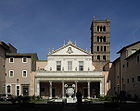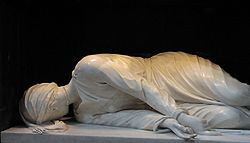
Santa Cecilia in Trastevere
Encyclopedia

Churches of Rome
There are more than 900 churches in Rome. Most, but not all, of these are Roman Catholic, with some notable Roman Catholic Marian churches.The first churches of Rome originated in places where Christians met. They were divided into three categories:...
, Italy, devoted to Saint Cecilia
Saint Cecilia
Saint Cecilia is the patroness of musicians and Church music because as she was dying she sang to God. It is also written that as the musicians played at her wedding she "sang in her heart to the Lord". St. Cecilia was an only child. Her feast day is celebrated in the Roman Catholic, Anglican,...
, in the Trastevere
Trastevere
Trastevere is rione XIII of Rome, on the west bank of the Tiber, south of Vatican City. Its name comes from the Latin trans Tiberim, meaning literally "beyond the Tiber". The correct pronunciation is "tras-TEH-ve-ray", with the accent on the second syllable. Its logo is a golden head of a lion on a...
rione
Rioni of Rome
A rione is an Italian term used since the Middle Ages to name the districts of Rome, according to the administrative divisions of that time. The word originates from the Latin word regio A rione (pl. rioni) is an Italian term used since the Middle Ages to name the districts of Rome, according to...
.
History
The first church on this site was founded probably in the 3rd century, by Pope Urban IPope Urban I
Pope Saint Urban I was Pope from 14 October 222 to 230. He was born in Rome, Roman Empire and succeeded St. Callixtus I who had been martyred. For centuries it was believed that Urban too was martyred...
; it was devoted to the Roman martyr Cecilia, martyred it is said under Marcus Aurelius Severus Alexander, by the late fifth century, for in the synod of 499 of Pope Symmachus
Pope Symmachus
Saint Symmachus was pope from 498 to 514. His tenure was marked by a serious schism over who was legitimately elected pope by the citizens of Rome....
, the church is indicated with the Titulus Ceciliae. Tradition holds that the church was built over the house of the saint. The baptistery associated with this church, together with the remains of a Roman house of the early Empire, was found during some excavations under the Chapel of the Relics. On 22 November 545, Pope Vigilius
Pope Vigilius
Pope Vigilius reigned as pope from 537 to 555, is considered the first pope of the Byzantine Papacy.-Early life:He belonged to a aristocratic Roman family; his father Johannes is identified as a consul in the Liber pontificalis, having received that title from the emperor...
was celebrating the saint in the church, when the emissary of Empress Theodora
Theodora
Theodora is a name of Greek origin, meaning "God's gift". It is the feminine form of the Greek name, Θεόδωρος meaning "God's gift" , neuter gender...
, Antemi Scribone, captured him.
Pope Paschal I
Pope Paschal I
Pope Saint Paschal I was pope from January 25, 817 to February 11, 824. A native of Rome and son of Bonosus, he was raised to the pontificate by the acclamation of the clergy, shortly after the death of Pope Stephen IV, and before the sanction of the emperor Louis the Pious had been obtained - a...
rebuilt the church in 822, and moved here the relics of St Cecilia from the catacombs of St Calixtus
Pope Callixtus I
Pope Saint Callixtus I or Callistus I was pope from about 217 to about 222, during the reigns of the Roman Emperors Elagabalus and Alexander Severus...
. More restorations followed in the 18th century.
The Cardinal Priest of the Titulus S. Caeciliae is Carlo Maria Martini
Carlo Maria Martini
Carlo Maria Martini, SJ is an Italian Cardinal of the Catholic Church. He was Archbishop of Milan from 1980 to 2002, and was elevated to the cardinalate in 1983.-Early life and education:...
. Among the previous titulars are Pope Stephen III
Pope Stephen III
Pope Stephen III was pope from August 1 or August 7, 768 to January 24, 772. He was a native of Sicily.He came to Rome during the pontificate of Gregory III and gradually rose to high office in the service of successive popes....
, Adam Easton
Adam Easton
Adam Easton was an English Cardinal, born at Easton in Norfolk.He joined the Benedictines at Norwich moving on to the Benedictine Gloucester College, Oxford where he became one of the most outstanding students of his generation, being especially proficient in Hebrew...
, Thomas Wolsey and Giuseppe Maria Doria Pamphili.
Art and architecture
The church has a façade built in 1725 by Ferdinando FugaFerdinando Fuga
Ferdinando Fuga was an Italian architect, whose main works were realized in Rome and Naples in the Baroque style.-Biography:Born in Florence, he began to work in that city as a pupil of Giovanni Battista Foggini. In 1717 he moved to Rome, to continue his apprentice studies...
, which incloses a courtyard decorated with ancient mosaics, columns and a cantharus (water vessel). Its decoration includes the coat of arms and the dedication to the titular cardinal who paid for the facade, Francesco Cardinal Acquaviva d'Aragona.
Among the artifacts remaining from the 13th century edifice are a mural painting depicting the Final judgment (1289-93) by Pietro Cavallini
Pietro Cavallini
Pietro Cavallini was an Italian painter and mosaic designer working during the late Middle Ages. Little is known about his biography, though it is known he was from Rome, since he signed pictor romanus....
in the choir of the monks, and the ciborium
Ciborium (architecture)
In ecclesiastical architecture, a ciborium is a canopy or covering supported by columns, freestanding in the sanctuary, that stands over and covers the altar in a basilica or other church. It may also be known by the more general term of baldachin, though ciborium is often considered more correct...
(1293) in the presbytery
Presbytery (architecture)
The presbytery is the name for an area in a church building which is reserved for the clergy.In the oldest church it is separated by short walls, by small columns and pilasters in the Renaissance ones; it can also be raised, being reachable by a few steps, usually with railings....
by Arnolfo di Cambio
Arnolfo di Cambio
Arnolfo di Cambio was an Italian architect and sculptor.-Biography:Arnolfo was born in Colle Val d'Elsa, Tuscany....
. The Gothic ciborium is surrounded by four marble columns white and black, decorated with statuettes of angels, saints, prophets, and evangelists. The apse has remains of 9th century mosaics depicting the Redeemer with Saints Paul
Paul of Tarsus
Paul the Apostle , also known as Saul of Tarsus, is described in the Christian New Testament as one of the most influential early Christian missionaries, with the writings ascribed to him by the church forming a considerable portion of the New Testament...
, Cecilia, Paschal I, Peter
Saint Peter
Saint Peter or Simon Peter was an early Christian leader, who is featured prominently in the New Testament Gospels and the Acts of the Apostles. The son of John or of Jonah and from the village of Bethsaida in the province of Galilee, his brother Andrew was also an apostle...
, Valerian, and Agatha.
The ceiling of Cappella dei Ponziani was decorated God the Father with evangelists (1470) by Antonio del Massaro
Antonio del Massaro
Antonio del Massaro da Viterbo, or Antonio da Viterbo, nicknamed il Pastura was an Italian painter.-Life and career:...
(Antonio da Viterbo or il Pastura). The Cappella delle Reliquie was frescoed and provided with an altarpiece by Luigi Vanvitelli
Luigi Vanvitelli
Luigi Vanvitelli was an Italian engineer and architect. The most prominent 18th-century architect of Italy, he practiced a sober classicizing academic Late Baroque style that made an easy transition to Neoclassicism.-Biography:Vanvitelli was born at Naples, the son of a Dutch painter of land and...
. The nave is frescoed with the Apotheosis of Santa Cecilia (1727) by Sebastiano Conca
Sebastiano Conca
Sebastiano Conca was an Italian painter.He was born at Gaeta, then part of the Kingdom of Naples, and apprenticed in Naples under Francesco Solimena. In 1706, along with his brother Giovanni, who acted as his assistant, he settled at Rome, where for several years he worked in chalk only, to...
. The church contains two altarpieces by Guido Reni
Guido Reni
Guido Reni was an Italian painter of high-Baroque style.-Biography:Born in Bologna into a family of musicians, Guido Reni was the son of Daniele Reni and Ginevra de’ Pozzi. As a child of nine, he was apprenticed under the Bolognese studio of Denis Calvaert. Soon after, he was joined in that...
: Saints Valerian and Cecilia and a Decapitation of Saint Cecilia (1603).

Renaissance
The Renaissance was a cultural movement that spanned roughly the 14th to the 17th century, beginning in Italy in the Late Middle Ages and later spreading to the rest of Europe. The term is also used more loosely to refer to the historical era, but since the changes of the Renaissance were not...
sculptor Stefano Maderno
Stefano Maderno
Stefano Maderno was an Italian sculptor.-Biography:News about Maderno's life are scarce and often contradictory...
. This sculpture reportedly is modelled on the saint's body as seen in 1595, when her tomb was opened. The statue subtly depicts the saint's decapitation. In addition, it also it is meant to underscore the supposed incorruptibility of her cadaver (an attribute of some saints), which miraculously still had congealed blood after centuries. This statue could be conceived as proto-Baroque, since it depicts no idealized moment or person, but a theatric scene, a naturalistic representation of a dead or dying saint. It is striking, because it precedes by decades the similar high-Baroque sculptures of Gian Lorenzo Bernini
Gian Lorenzo Bernini
Gian Lorenzo Bernini was an Italian artist who worked principally in Rome. He was the leading sculptor of his age and also a prominent architect...
(for example, his Beata Ludovica Albertoni
Beata Ludovica Albertoni
The "Beata Ludovica Albertoni" is a funerary monument in the specially designed Altieri Chapel in the church of San Francesco a Ripa in Trastevere, Rome, Italy....
) and Melchiorre Caffà
Melchiorre Caffà
Melchiorre Cafà was a sculptor from Malta. Cafà began a promising career in Baroque Rome but this was cut short by his premature death following a work accident.- Biography :...
(Santa Rosa de Lima
Santa Rosa de Lima
-Description:The city is named after St. Rose of Lima, born on 1586 in Lima . Its "fiestas patronales" are during the month of August, when the city gets full of vendors from around the country selling a wide range of articles and food. The city is also known as the "capital of commerce" in La...
).
The crypt is also noteworthy, decorated with cosmatesque
Cosmatesque
Cosmatesque, or Cosmati, is a style of geometric decorative inlay stonework typical of Medieval Italy, and especially of Rome and its surroundings. It was used most extensively for the decoration of church floors, but was also used to decorate church walls, pulpits, and bishop's thrones...
style, keeping the relics of St. Cecilia and St. Valerian
External links
- Kunsthistorie.com, photogallery

